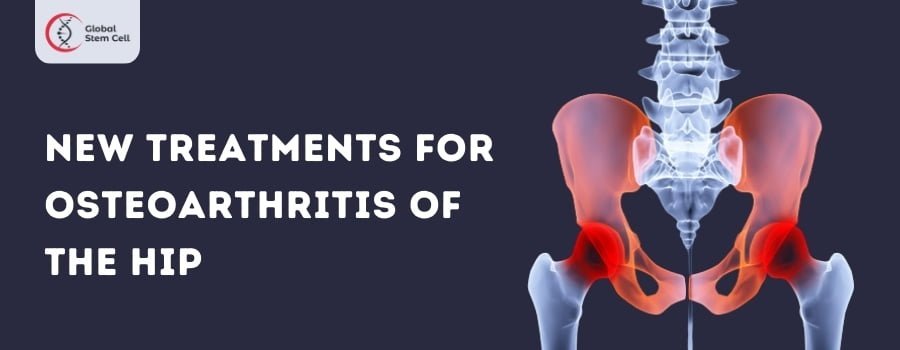
New Hope for Hips – Exploring Stem Cell Therapy for Osteoarthritis
Table of Content
For millions of people worldwide, hip osteoarthritis is a constant companion, casting a shadow over daily activities and limiting mobility. Traditional treatment options, while helpful, often address symptoms rather than the root cause. But what if there was a new approach, offering the potential for regeneration and renewed hope?
This blog post delves into the exciting realm of stem cell therapy as a groundbreaking option for treating hip osteoarthritis. We’ll explore the potential of these remarkable cells to repair damaged cartilage, reduce pain, and improve joint function, offering patients a chance to reclaim their active lives.
Understanding Osteoarthritis of the Hip
Osteoarthritis (OA) of the hip is a degenerative joint disease that affects the hip joint. It is the most common type of arthritis and occurs when the protective cartilage that cushions the ends of the bones in the hip joint gradually wears down over time. As a result, the bones begin to rub against each other, causing pain, stiffness, and reduced joint mobility. Here are some key points to understand about osteoarthritis of the hip:
Causes
- Age: OA is more common in older adults, and the risk increases with age.
- Genetics: There may be a genetic predisposition to developing OA.
- Joint injuries: Previous hip injuries or trauma can contribute to the development of OA.
- Obesity: Excess body weight puts additional stress on the hip joints, increasing the risk of OA.
Symptoms
- Pain: Persistent pain in the hip joint is a common symptom, especially during or after movement.
- Stiffness: The hip joint may feel stiff, making it challenging to move, especially after periods of inactivity.
- Reduced range of motion: As the cartilage wears away, the hip joint’s ability to move smoothly decreases.
- Grating or clicking sensations: Some people may experience a grating or clicking sound when moving the hip.
Diagnosis
- Physical examination: A healthcare provider will assess the range of motion, joint stability, and signs of inflammation in the hip.
- X-rays: Imaging studies, such as X-rays, can reveal joint damage, narrowing of the joint space, and the presence of bone spurs.
- MRI or CT scans: These may be used to provide more detailed images of the hip joint.
Surgery
In severe cases where conservative treatments are ineffective, surgical options may be considered.
- Hip replacement: This involves replacing the damaged hip joint with an artificial one.
- Prevention: Maintaining a healthy weight and engaging in regular low-impact exercise can help reduce the risk of developing hip OA.
Protecting the hip joint from injuries and managing joint health can also contribute to prevention.
Conventional Treatment Approaches
Conventional treatment approaches for osteoarthritis of the hip typically focus on managing symptoms, improving joint function, and enhancing overall quality of life. These approaches may involve a combination of lifestyle modifications, medications, physical therapy, and, in more severe cases, surgical interventions. Here’s an overview of conventional treatment options:
Medications
- Pain relievers (analgesics): Acetaminophen is often recommended for mild to moderate pain. Nonsteroidal anti-inflammatory drugs (NSAIDs) such as ibuprofen or naproxen may be used to reduce pain and inflammation.
- Topical creams or patches: These may contain NSAIDs or other analgesic agents and can be applied directly to the skin over the affected hip joint.
Physical Therapy
- A physical therapist can design a tailored exercise program to strengthen the muscles around the hip joint, improve joint flexibility, and enhance overall mobility.
- Range-of-motion exercises, stretching, and low-impact aerobic activities can be beneficial.
Lifestyle Modifications
- Weight management: Maintaining a healthy weight can reduce stress on the hip joints and slow down the progression of osteoarthritis.
- Assistive devices: Canes or walkers may help reduce pressure on the hip joint during weight-bearing activities.
Joint Injections
- Corticosteroid injections: These injections can provide temporary relief by reducing inflammation in the hip joint. However, their effects are not long-lasting, and repeated use may have limitations.
Viscosupplementation
In some cases, injections of hyaluronic acid (a substance found in joint fluid) may be used to improve joint lubrication and reduce pain.
Surgical Interventions
- Arthroscopy: This minimally invasive procedure involves using a tiny camera to assess and possibly repair damage within the hip joint.
- Osteotomy: Involves reshaping the bones to improve joint alignment and reduce stress on the affected area.
- Total hip replacement (arthroplasty): In advanced cases, where conservative measures are ineffective, a surgeon may replace the damaged hip joint with an artificial one.
Rehabilitation After Surgery
Physical therapy is often a crucial component of post-surgical rehabilitation to regain strength, flexibility, and function.
How stem cell therapy works for osteoarthritis of the Hips?
Stem cell therapy for osteoarthritis of the hips is an innovative approach that aims to harness the regenerative potential of stem cells to promote tissue repair and reduce inflammation in the affected joint. Here’s how it typically works:
Stem Cell Collection: The procedure usually begins with the collection of stem cells from the patient’s own body. This can involve harvesting stem cells from bone marrow or adipose (fat) tissue. In some cases, stem cells may also be obtained from donor sources.
Isolation and Processing: Once collected, the stem cells are isolated and processed to concentrate them into a therapeutic solution. This solution may also contain growth factors and other bioactive molecules that can further enhance tissue repair and regeneration.
Injection into the Hip Joint: The concentrated stem cell solution is then injected directly into the affected hip joint under imaging guidance (such as ultrasound or fluoroscopy). This ensures precise delivery of the cells to the site of injury or degeneration within the joint.
Regenerative Effects: Once injected, the stem cells can exert several regenerative effects:
- Differentiation: Stem cells have the ability to differentiate into various cell types, including cartilage cells (chondrocytes) and cells that contribute to joint tissue repair.
- Anti-inflammatory effects: Stem cells release anti-inflammatory molecules that can help reduce inflammation within the joint, thereby alleviating pain and promoting healing.
- Stimulation of local repair processes: Stem cells can stimulate the body’s natural repair mechanisms, including the production of new cartilage tissue and the recruitment of other healing cells to the site of injury.
Monitoring and Follow-Up: After the procedure, patients are typically monitored closely to assess their response to treatment. Follow-up evaluations may include imaging studies (such as MRI) and assessment of symptoms and joint function.
Where can I get Stem Cell Treatment for osteoarthritis of the Hips?
Stem cell treatment for osteoarthritis of the hips is available in several countries, including Thailand, India, and Mexico. It’s important to note that the availability and regulations surrounding stem cell therapy can vary across countries. Here’s an overview of each country:
Thailand
- Medical Tourism Hub: Thailand is a popular destination for medical tourism, offering a range of medical services, including stem cell therapy.
- Quality Healthcare Facilities: The country boasts modern healthcare facilities and experienced medical professionals, making it an attractive option for those seeking stem cell treatments.
- Regulations: Thailand has regulations in place for stem cell therapy, and patients are advised to seek treatment from licensed and reputable clinics.
India
- Advanced Medical Facilities: India has advanced medical facilities and a growing reputation for providing high-quality healthcare services.
- Stem Cell Clinics: Stem cell therapy is offered at various clinics and hospitals across the country, with experienced healthcare professionals.
- Regulations: India has regulatory frameworks in place for stem cell therapy, and patients should choose accredited facilities.
Mexico
- Affordable Healthcare: Mexico is known for offering more affordable healthcare options compared to some Western countries, attracting medical tourists.
- Stem Cell Clinics: There are clinics in Mexico that provide stem cell treatments, but patients should carefully research and choose reputable facilities.
- Regulations: Mexico has its own regulations governing stem cell therapy, and patients are encouraged to ensure that clinics comply with established standards.
Before considering stem cell treatment in any country, it’s crucial for patients to:
- Research Clinics: Look for reputable clinics with a track record of successful stem cell treatments for osteoarthritis.
- Check Credentials: Ensure that healthcare providers are qualified, and the clinics adhere to proper medical and ethical standards.
- Understand Regulations: Be aware of the regulatory environment for stem cell therapy in the chosen country.
- Consult with Healthcare Professionals: Seek advice from healthcare professionals, preferably those with expertise in stem cell therapy, to assess the suitability of the treatment for your specific condition.
Ready to explore stem cell treatment for osteoarthritis relief? Consult with your healthcare provider and consider reputable clinics in countries like Thailand, India, or Mexico. Make informed decisions for your well-being today!





